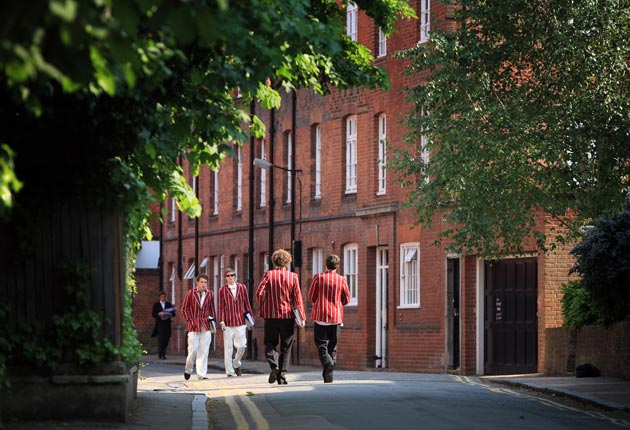A Government of straight, white, privately educated men
Sean O'Grady finds an absence of diversity in the 119 people now running the country

If Britain looked like its government, about four million adults would have gone to Eton, there would be no black people, and for every one woman there would be six men.
Analysis by The Independent of the social origins of members of the coalition government – the most extensive exercise of its kind – reveals that one-tenth of all the minsters in the Government attended just one public school: Eton. Overall, two-thirds of ministers were educated partly or entirely outside the mainstream state school system, and one in five went to one of the old established top public schools.
Also, in stark contrast to the reality of life outside Westminster and Whitehall, there are no black members of the British government, and only three Asians and two openly gay men. Old Wellingtonians alone outnumber the products of secondary modern and technical schools.
Three Old Etonians are in the Cabinet or attend it, around the same as could be sometimes found in Mrs Thatcher’s time, and down from the six at Harold Macmillan’s top table half a century ago or the eight in Neville Chamberlain’s cabinets before the Second World War. The OEs became extinct in the Blair-Brown era, but are back in some numbers – a dozen in government, enough for a soccer team and a sub. They form what has been likened to a Mafia-style network in important jobs in and around Westminster, not excluding Boris Johnson, the Mayor of London and fellow ex-Bullingdonian friend of Mr Cameron.
The educational background of the Liberal Democrats in government is not dramatically out of line with their Conservative counterparts, adding to suspicions that the coalition is as much a social as a political affair. Some 52 per cent of Liberal Democrat ministers went to state schools, against 35 per cent of Tories; both way lower than the 74 per cent in the last Labour Government and the 93 per cent of all pupils nationally who go to state secondary schools. Cabinet ministers Nick Clegg and Chris Huhne both went to Westminster School.
In some respects, indeed, the Liberal Democrats are even more divorced from the nation as a whole – their ministers are 100 per cent white. Despite efforts by both parties to improve the showing of ethnic minorities, the top echelons of power remain glaringly white.
While there has always been a gap between the profile of the general population and most of the professions, including politics, the unrepresentative nature of the Government may weaken its ability to stay in touch with the moods and aspirations of mainstream voters, and to force through unpopular spending cuts that will, according to the Institute for Fiscal Studies, hit the poorest in society hardest. It also makes its meritocratic credentials and claims that “we are all in this together” look less credible.
In particular, at a time when the Government is attempting radical reform of the state school system and has cancelled more than 700 school building projects, many may also find it odd that the education department only contains one minister who completed his entire secondary education at a mainstream state school. The Secretary of State Michael Gove (Robert Gordon’s College, Aberdeen and Oxford), plus junior ministers Lord Hill of Oareford (Highgate and Cambridge) and Sarah Teather (Leicester Grammar and Cambridge) were educated independently. The Schools Minister, Nick Gibb, experienced both worlds before going on to Durham. Only Tim Loughton, minister for children and families, went to a comprehensive before Warwick and following many of his colleagues to Cambridge. Mr Gove’s Special Adviser, Henry de Zoete, was in the year above Prince William at Ludgrove and Eton. He took a degree at Bristol. The Culture and the Northern Ireland departments’ ministers are entirely public school.
The Government’s special advisers and political appointed civil servants generally also reflect a heavy public school bias. Among the more notable aides: Ed Llewellyn (Chief of Staff to the prime minister, Eton and Oxford), Rupert Harrison (Chief of staff to George Osborne, Head Boy at Eton and Oxford), Ellie Shawcross (Economic adviser to Mr Osborne, St Paul’s and Oxford) and Poppy Mitchell-Rose (another adviser to Mr Osborne, Fettes and Durham).
Oxbridge also exercises something of a stranglehold on the top of government: about seven in 10 minsters attending Cabinet, and approaching a half overall, went to Oxford and Cambridge, with London and Bristol the only other universities putting up much of a challenge. David Cameron joins a long of predecessors who went there, but the more recent ones – Harold Wilson, Edward Heath and Margaret Thatcher – were all at grammar schools.
That long tradition of the state grammar school and direct grant school as a ladder of opportunity for the less advantaged is only sparingly represented in this administration, and often by older member s such as Ken Clarke.
A second degree at London Business School is a more common phenomenon than it used to be, as is a training in accountancy.
A family link in politics also helps in the coalition: five have fathers who were MPs and two more married the daughters of Conservative cabinet misters. Three can trace their lineage back, with varying degrees of difficulty, to past prime ministers. The Chancellor, George Osborne, is the son-in-law of the Foreign Office minister Lord Howell; David Cameron is distantly related to Lord Astor, a whip. If you landed from Mars, you would conclude that Britain was a very small world indeed.
Additional research by James Burton
Join our commenting forum
Join thought-provoking conversations, follow other Independent readers and see their replies
Comments
Bookmark popover
Removed from bookmarks